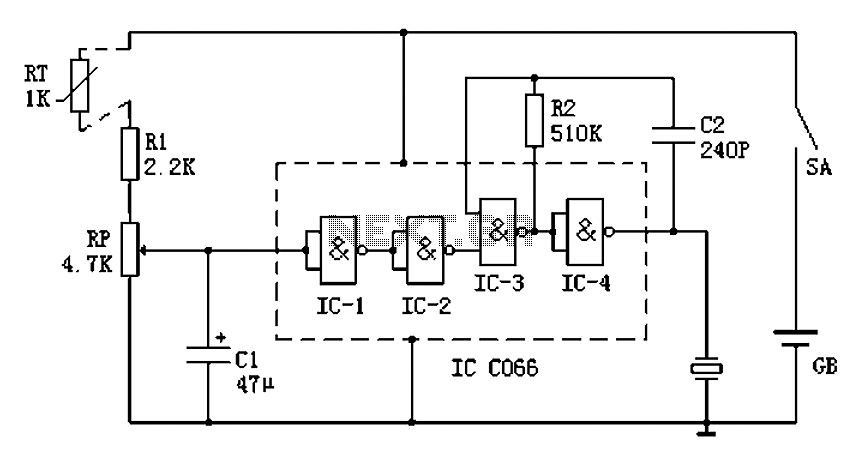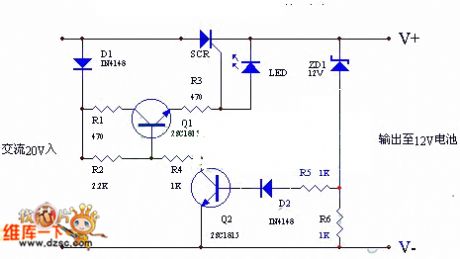
Open water notification Circuit Design

Boiling water on a kitchen gas stove can lead to issues such as spilling boiling water if the process is not monitored, which can extinguish the flame and cause gas leakage. A notification device can address this problem. The circuit employs a thermistor as the temperature sensor. As the water temperature increases, the resistance of the thermistor decreases, resulting in a higher voltage at point A. When this voltage exceeds a certain threshold, the inverter IC-1 outputs a low signal, while IC-2 outputs a high signal. This activation causes audio oscillators IC-3 and IC-4 to generate sound through piezoelectric ceramics. Conversely, when IC-2 outputs a low signal, the audio oscillators remain silent. The circuit utilizes a C066 two-input NAND gate and operates within a voltage range of 3V to 18V, with a power supply of 3V to 6V. The thermistor has a resistance of approximately 1kΩ, and the selected piezoelectric ceramics have a diameter of 27mm. Standard 1/8 or 1/4W metal film resistors are used.
For the production and testing method, two discarded fluorescent starter shells are utilized, secured with iron clamps and screws. One starter is positioned in the kettle's spout to measure water temperature. The thermistor's two pins are soldered onto the other starter cover and encapsulated within the shell, ensuring the thermistor is close to the shell wall for accurate heating. After verifying all components and connections, the system can be powered on for debugging. The temperature sensor is placed in the kettle's spout, and adjustments to the variable resistor (RP) are made until the water boils, at which point the piezoelectric ceramic emits sound. This testing may be repeated multiple times before the device is officially used. The sound frequency can be altered by changing the capacitance of C2, and if a louder sound is desired, transistors can be added to amplify the output from IC-4.
The circuit design effectively combines temperature sensing and sound notification to ensure safe boiling of water, preventing potential hazards associated with unattended boiling. The use of common electronic components simplifies the assembly and makes the system cost-effective while providing a reliable solution for monitoring boiling water. Boil water on the kitchen gas stove, once the water is boiling, if not stalled, spilling boiling water will come out, the flame extinguished. Gas spills, very safe. Water can s olve this problem after opening notification device. Circuit works : The circuit uses a thermistor as the temperature sensing element, when the water temperature rises, the thermistor resistance decreases, A point potential increases, when the A point potential is higher than the IC-1 inverters convert voltage, IC-1 will output low, IC-2 output high. So that IC-3, IC-4 audio oscillator work composed, piezoelectric ceramics sound. When IC-2 output low, IC-3, IC-4 consisting of audio oscillator is not working, piezoelectric ceramics silent.
IC selects C066 two-input NAND gate four, working voltage 3V ~ 18V, the power supply circuit is 3V ~ 6V; RT thermistor resistance is about selected 1k ; piezoelectric ceramics selected diameter of 27mm; use an ordinary resistor 1/8 or 1/4W metal film resistors. Production and Testing Method : find two waste fluorescent starter shell, made with iron clamps, snapping the top two starters and secured with screws.
Wherein a starter can be set in the mouth of the kettle to get water temperature. Thermistor two pins welded on the other starter cover and filled shell, attention must be close to the thermistor within the shell wall, it is easy to heat. Welding on the outer lead thermistor temperature sensors on the well. After all the components check and correct weld can turn on debugging, the temperature sensor set in the kettle mouth, adjusting RP and other water boils, the piezoelectric ceramic sheet just sound, several times repeated testing, it can officially use.
To change the sound frequency can vary the capacity C2. If you feel that the sound is not enough, you can add transistors in the output of IC-4, amplification sound effects.
For the production and testing method, two discarded fluorescent starter shells are utilized, secured with iron clamps and screws. One starter is positioned in the kettle's spout to measure water temperature. The thermistor's two pins are soldered onto the other starter cover and encapsulated within the shell, ensuring the thermistor is close to the shell wall for accurate heating. After verifying all components and connections, the system can be powered on for debugging. The temperature sensor is placed in the kettle's spout, and adjustments to the variable resistor (RP) are made until the water boils, at which point the piezoelectric ceramic emits sound. This testing may be repeated multiple times before the device is officially used. The sound frequency can be altered by changing the capacitance of C2, and if a louder sound is desired, transistors can be added to amplify the output from IC-4.
The circuit design effectively combines temperature sensing and sound notification to ensure safe boiling of water, preventing potential hazards associated with unattended boiling. The use of common electronic components simplifies the assembly and makes the system cost-effective while providing a reliable solution for monitoring boiling water. Boil water on the kitchen gas stove, once the water is boiling, if not stalled, spilling boiling water will come out, the flame extinguished. Gas spills, very safe. Water can s olve this problem after opening notification device. Circuit works : The circuit uses a thermistor as the temperature sensing element, when the water temperature rises, the thermistor resistance decreases, A point potential increases, when the A point potential is higher than the IC-1 inverters convert voltage, IC-1 will output low, IC-2 output high. So that IC-3, IC-4 audio oscillator work composed, piezoelectric ceramics sound. When IC-2 output low, IC-3, IC-4 consisting of audio oscillator is not working, piezoelectric ceramics silent.
IC selects C066 two-input NAND gate four, working voltage 3V ~ 18V, the power supply circuit is 3V ~ 6V; RT thermistor resistance is about selected 1k ; piezoelectric ceramics selected diameter of 27mm; use an ordinary resistor 1/8 or 1/4W metal film resistors. Production and Testing Method : find two waste fluorescent starter shell, made with iron clamps, snapping the top two starters and secured with screws.
Wherein a starter can be set in the mouth of the kettle to get water temperature. Thermistor two pins welded on the other starter cover and filled shell, attention must be close to the thermistor within the shell wall, it is easy to heat. Welding on the outer lead thermistor temperature sensors on the well. After all the components check and correct weld can turn on debugging, the temperature sensor set in the kettle mouth, adjusting RP and other water boils, the piezoelectric ceramic sheet just sound, several times repeated testing, it can officially use.
To change the sound frequency can vary the capacity C2. If you feel that the sound is not enough, you can add transistors in the output of IC-4, amplification sound effects.





